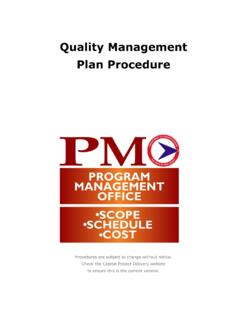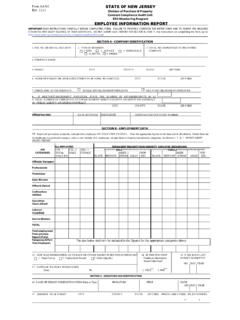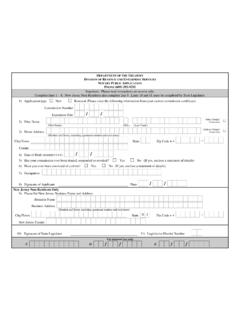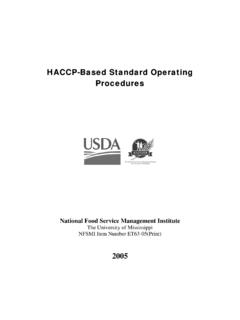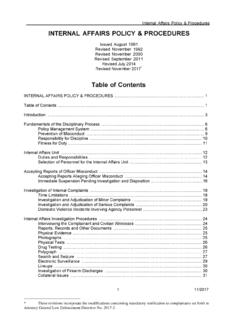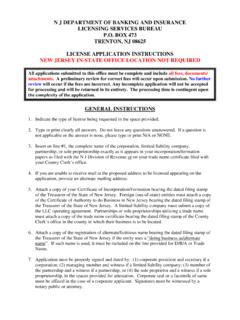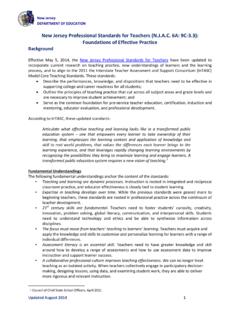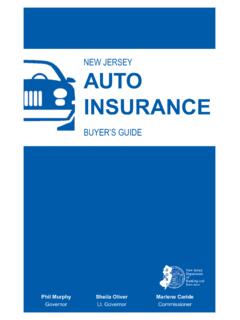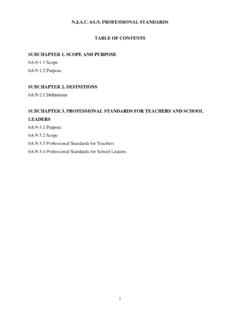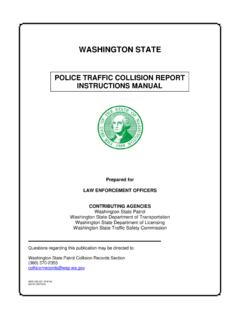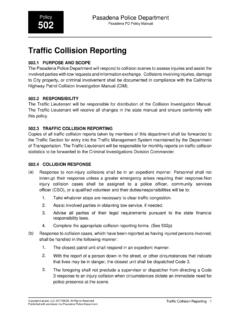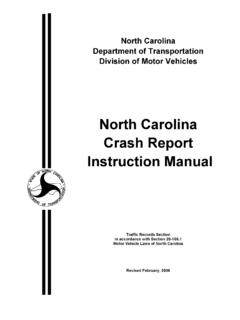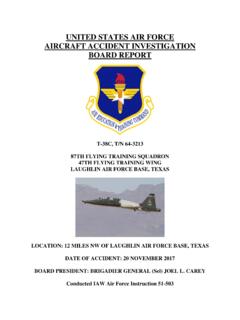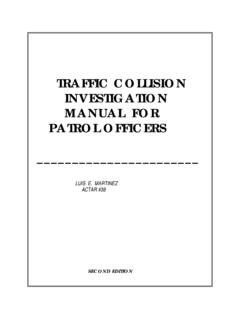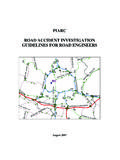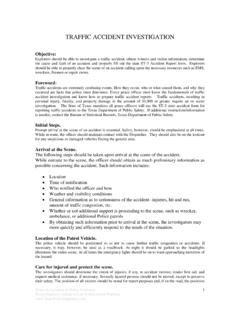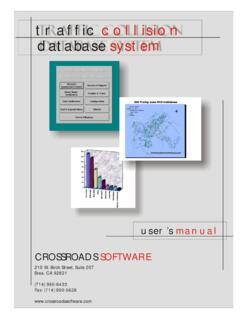Transcription of Police Guide for Preparing Reports of Motor Vehicle Crashes
1 - Police Guide for Preparing Reports of Motor Vehicle Crashes Revised 2005 2 Introduction This comprehensive manual was created by a dedicated group of professionals to help you understand what the requirements are in filing the NJTR- 1. Each data element is explained in detail and provides you with information supported by law and expert opinion. 39:4-131 states: Every law enforcement officer who investigates a Vehicle accident* of which report must be made as required in this Title, or who otherwise prepares a written report as a result of an accident* or thereafter by interviewing the participants or witnesses, shall forward a written report of the accident* to the division, on forms furnished by it, within five days after this investigation of the accident*.
2 The investigation and reporting of Motor Vehicle Crashes is a necessary duty of a Police officer. Reports are intended to help reduce the number of Crashes , deaths and injuries through the collection of data elements and study how they occur. You play a vital role in the collection of this data and it is imperative that you understand each piece of information that you enter. We gratefully acknowledge the following individuals for making this manual a reality. NJDOT, Bureau of Safety Programs STRCC Chairman, William Beans New Jersey State Police ; Committee Chairmen Sergeant First Class Robert Parlow NJDOT, Information Technology; NJTR1 Designer Thomas Kennedy Voorhees Township Police Department; NJTR-1 Manual Designer- Lieutenant Mark J.
3 Wilson New Jersey State Police Sergeant Scott Wishart Washington Township Police Department, Gloucester County Sergeant Steven Branco Washington Township Police Department, Bergen County Chief William Cicchetti Bergenfield Police Department Chief Thomas Lucas Colts Neck Police Department Sergeant Richard Maxwell New Jersey Division of Highway Traffic Safety Al Tindall New Jersey Motor Vehicle Commission Marcy Klein, Patricia Jones New Jersey State Police , FARS Unit Lisa Glodowski, Sandra Jenkins New Jersey State Office of Information Technology Joseph Decker, Debbie Johnson New Jersey Motor Vehicle Commission Stanley Cierniak University of Rutgers, Police Training Kennard Wondrack, Raymond Chintall Federal Highway Administration Karen Yunk NJDOT, Bureau of Safety Programs Kevin Conover, Lisa Kaye, Penny Jones * Statutory Language 3 History of Crash Reporting Historically, most traffic crash Reports were intended, and used, primarily as simple Who.
4 What, Where, When and maybe Why chronicles. In this age of ever decreasing resources, and ever increasing needs, the ability to provide timely, accurate data to Highway Safety Officials becomes increasingly urgent, because it allows traffic safety officials to do more with less . Each traffic Crash report is a memorialization of a reportable crash. The circumstances are rarely ideal as the officer must perform triage in attending to injured persons, minimize the impact and risk to surrounding traffic and then survey and analyze the crash scene.
5 Pursuant to the requirements of 39:4-131, an officer investigating a Motor Vehicle crash must submit to Motor Vehicle Commission a completed crash report within five (5) days. The Reports are submitted by all law enforcement agencies in the State for any reportable Motor Vehicle traffic crash resulting in injury to or death of any person, or damage to property of any one person in excess of $ As a result, approximately 320,000 (2003) crash Reports are produced annually. The Division of Highway Traffic Safety (DHTS) and the New Jersey Department of Transportation are responsible for allocating funds from the National Highway Traffic Safety Administration (NHTSA) and the Federal Highway Administration (FHWA) for the purpose of creating programs aimed at improving the safety of New Jersey roadways.
6 Traffic crash analysis affects these and other agencies, as the crash report is the only source of their information. As such, crash reporting information is critical in the decision-making process of numerous agencies. Some of them are: Division of Highway Traffic Safety Motor Vehicles Commission Division of State Police Department of Transportation Department of the Treasury Department of Insurance Department of Education Department of Human Services Office of Emergency Management Services County and Municipal Traffic Engineers County and Municipal Traffic Officers 4 Preliminary Instruction Guide On July 16, 1997.
7 The National Safety Council s Board of Directors passed a motion to eliminate the word ACCIDENT and replace it with the word CRASH. The reason for the motion was to change people s way of thinking about Crashes . An accident is defined as An unexpected or undesired event, chance or fortune while a crash is to cause a Vehicle or aircraft to have a collision, to be involved in a crash. This reinforces the philosophy that Crashes don t just happen; they have causes and can be prevented. Although Title 39 has not yet changed to reflect this new trend in terminology the changes have been made in this manual.
8 The most recent NJTR-l went into effect on January 1, 2006. The report was renumbered through input from officers to assist you in the completion of the form. Some changes throughout the new report should be noted: The report was changed from 124 blocks to 144 blocks. Important points All 144 boxes on the Crash report must be completed, even if you only enter a dash. Be very specific when entering the location of the crash. This information must be completed in order to pinpoint the exact location of the crash for geo-code processing.
9 All reportable crash Reports , including fatals, must be forwarded to the New Jersey Department of Transportation through the New Jersey Motor Vehicle Commission. Use a dash (-) to indicate non-applicable information in all blocks. Use double zeros (00) to indicate the required information is unknown in blocks 96 -133. 99 Other is no longer shown in each category. Write in 99 in the boxes where no choices for Other apply and you will explain in the narrative. If a box calls for a two digit numeric answer be sure to fill in both digits, 01,02,03 List and number occupied vehicles first, then unoccupied vehicles, then bicyclists and pedestrians on the report When entering intersecting municipal street names, enter the numeric streets first and then the alpha streets in alphabetical order.
10 A pedalcycle is considered a Vehicle for purposes of crash reporting, except when coding ejection from Vehicle (box 85). A pedalcyclist is not coded as being ejected from the cycle if involved in a crash. A person sitting behind the wheel of a parked Vehicle should not have their information listed in the operator boxes (26-34, 56-64) but listed that information in the narrative (box 135) If a Vehicle or a pedestrian caused the crash and DID NOT have any contact with a Motor Vehicle , explain the pedestrian information box 135 and enter a dash (-) in boxes 26 and/or 56.
